
MAY CONTAIN NUTS

Search Shorpy
SHORPY ART

Framed or unframed, desk size to sofa size, printed by us in Arizona and Alabama since 2007. Explore now.
Join and Share
Ad-Free Shorpy
Shorpy is funded by you. Patreon contributors get an ad-free experience.
Learn more.

Recent comments
- Say what??
- Grapes?!
- A Beautiful Moment
- Such joy
- Bethune-Cookman University today...
- Yellow sky at morning
- Side Winder
- Air Quality?
- Sojourner Truth riot
- None were so blind(ed)
- The less famous sister
- Good ol' days?
- Rise and Fall
- Goo Goo Ga Joob
- Ticket Retention
- Not the only one
- Vagaries of War
- Killed by Amtrak
- Back to the Future
- Wanted --
- If you can't stand the light
- Centralized Traffic Control, I believe
- What's really happening
- Heckuva remote control!
- Sometimes — Things Go Bump!
- I SEE THE LIGHT
- Union Switch and Signal Company
- Get That Light Out Of My Eyes
- Eggs. Eggs. Eggs. The Egg Man is Here!
- Foreboding caption
Member Photos
The Shorpy
Print Emporium
Print Emporium
Search Shorpy
Search results -- 30 results per page
- Visiting the Torpedo Boats: 1906
- New Orleans circa 1906. "Visiting the torpedo boats." The Porter and the Dupont . 8x10 inch dry plate glass negative, ... the right, the French Market.
Capt. Nat's Torpedo Boats They were TB 6 and 7 in the Navy's numbering system. "Capt. Nat" ... Posted by Dave - 08/09/2012 - 6:47pm -
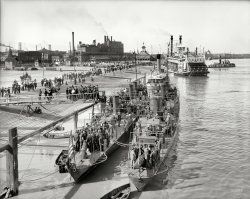
- A.C. Pier: 1904
- ... Company. View full size.
Sailing / Pulling Boats Note also the two graceful sailing/pulling boats. Too bad we cannot tell if they are double-enders or what. See the ... broken stringer on the pier, to the left of the pulling boats.
Catboats! Great to see so many Jersey catboats in one photo. ... Posted by Dave - 06/16/2014 - 10:01am -
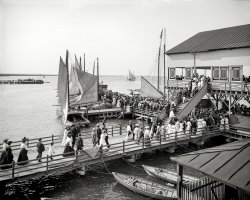
- Hydroplane Races 1960
- ... based in Tupelo and Grenada, Mississippi.
Hydroplane boats Really enjoyed seeing the hydroplane boats. My dad ("Wild Man Simmons") built and raced these boats in the 1950s and ... Posted by mr-ed - 11/04/2009 - 8:27am -
![Hydroplane Races 1960 This is John Griffin in a promotional hydroplane race at Nita Lake in 1960. John was world champion in Class A, Class B and Class C hydroplanes for a number of years in the 1950's. He was teamed with world class mechanic Ray Cother, who built the Konig engines John raced with. These two men were an unbeatable team when they were at their peak. They were based in Tupelo and Grenada, Mississippi.
Hydroplane boatsReally enjoyed seeing the hydroplane boats. My dad ("Wild Man Simmons") built and raced these boats in the 1950s and 60s. He lived in Tupelo Mississippi so he was probably a competitor! HA! Would like to hear from anybody that knew him or that has any more photographs of these boats and racers. cjs555@yahoo.com
Hydroplane boatsThis is my grandfather in this picture. I would love to know how you got it and if you had anymore. Thanks
My DadI am John Griffin Jr and that is my father. The picture brought back many memories. He did win many world championships and went on to win a world championship in the unlimited hydroplane class and had the distinction of being the fastest man on water for years. I would love to locate more pictures. johngriffin722@yahoo.com
[You can try contacting the member who submitted this photo by clicking their name ("mr-ed") above the photo and then the Contact tab on their Profile. -tterrace]
(ShorpyBlog, Member Gallery)](https://www.shorpy.com/files/images/nitalakeraceneg.thumbnail.jpg)
- Hotel Gus: 1905
- ... hotel or elsewhere for more fun in this resort area.
Boats Seems like a gas engine to me, Wade. No smokestack, nothing big ... However, they usually also had a prominent funnel.
Boats - Inquiring minds etc. I noticed the little runabout in the lower ... Posted by Dave - 09/12/2012 - 10:38am -
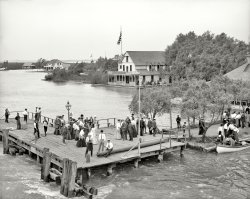
- Bromo Tower: 1912
- ... 250 West Pratt.
(The Gallery, Bizarre, Baltimore, Boats & Bridges, DPC) ... Posted by Dave - 04/27/2024 - 12:20am -
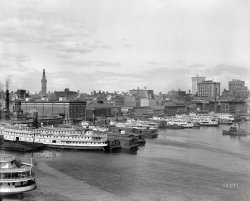
- Boats Leave Daily: 1905
- ... been a familiar sight for him.
I Looked It Up Wharf boats were used in places where the water level could change dramatically. I ...
(The Gallery, Boats & Bridges, DPC, Horses, Louisville) ... Posted by Dave - 12/05/2012 - 5:04pm -
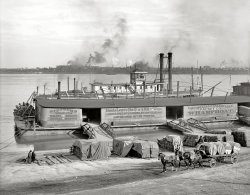
- The Sentinel: 1942
- ... for the Office of War Information.
Higgins Torpedo Boats Better known as PT Boats . As in PT-109 and McHale's Navy.
Sidearm by a strong arm What ... Posted by Dave - 08/30/2012 - 4:43pm -
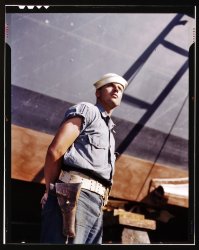
- Boats Abuilding: 1906
- ... or as barges, on the Great Lakes.
(The Gallery, Boats & Bridges, DPC, Railroads) ... Posted by Dave - 08/14/2012 - 2:37pm -
![Boats Abuilding: 1906 Ecorse, Michigan, circa 1906. "Great Lakes Engineering Works." Another view of this bustling shipyard on the Detroit River. Detroit Publishing Co. View full size.
Come 'n get it!Judging by the number of people in view and on the move, I'll bet somebody just called "LUNCH!!!"
Not only are these people long deadbut the ships these scurrying workers built are almost all likely long scrapped.
RerunsYou already posted this pic on July 13th.
[It's the same shipyard, but not the same photo. - Dave]
Lunch breakI do believe I see some of those lunch boxes... in use. Center of pic.
CautionTrip Hazard.
But many of the ships remainBy my count, at least 29 vessels (ranging from barges to large freighters) built by the Great Lakes Engineering Works between 1904 and 1960 remain extant. The oldest may be the former Detroit River trainferry Detroit, launched 12 November 1904 and, as of last year, waiting to be scrapped at Sandwich, Ontario. Amazingly, the 552-foot St. Marys Challenger, launched 17 February 1906 by GLEW as the William P. Snyder, is still in operation primarily on Lake Michigan hauling cement from Charlevoix, Michigan, primarily to Chicago, Milwaukee, and Grand Haven, and is still steam-powered, although not by her original triple expansion steam engine. At least nine other freighters built by GLEW are currently in operation, self-propelled or as barges, on the Great Lakes.
(The Gallery, Boats & Bridges, DPC, Railroads)](https://www.shorpy.com/files/images/4a21317a.thumbnail.jpg)
- Heart of Cleveland: 1950
- ... trackage into Grand Central Terminal.
(The Gallery, Boats & Bridges, Cleveland, Railroads) ... Posted by Dave - 04/06/2024 - 5:22pm -
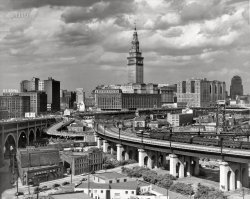
- Boats Bait Beer: 1910
- ... he got a whole silver dollar as tip.
(The Gallery, Boats & Bridges, G.G. Bain, NYC) ... Posted by Dave - 09/13/2011 - 12:35pm -
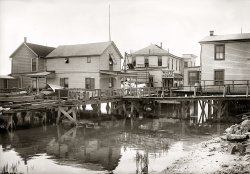
- Give me a sip!
- ... dad's beer or soda pop. View full size.
Higgins Boats Higgins boats are famous because they made the landing craft boats that were used in ... Posted by Retrophile - 09/14/2013 - 12:50am -
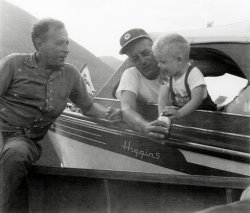
- Captain's Table: 1960
- ... River basin. All in good fun, old sport!
A boatload of boats From 1922 to 1938 Harold "Mike" Vanderbilt won six King’s Cups and ... Cup wins in the 1930s. I found references to him and boats named Enterprise, Rainbow, Ranger, and the Versatile shown here. How ... Posted by Dave - 02/26/2023 - 1:26pm -
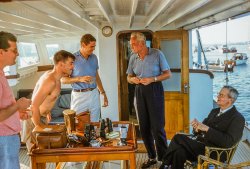
- Toy Boats: 1905
- ... can get more than two words out of him.
(The Gallery, Boats & Bridges, DPC, Landscapes) ... Posted by Dave - 07/23/2020 - 3:59pm -
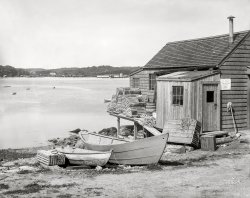
- Oyster Luggers: 1908
- ... what they're talking about. Look at what you learn (about boats and the oyster biz, in this case) in "Tonguers", "Long Tongs", "Couldn't ...
Great lines on that scow schooner in the background Boats like this, built with simple materials and for a specific purpose, are ... Posted by Dave - 08/08/2012 - 2:02pm -
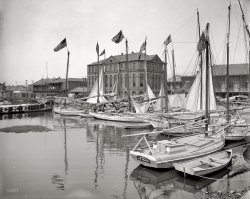
- Sleepy Sailors: 1899
- ... that mustaches are being over-waxed.
(The Gallery, Boats & Bridges, DPC, E.H. Hart) ... Posted by Dave - 02/07/2024 - 4:23pm -
![Sleepy Sailors: 1899 Aboard the U.S.S. Massachusetts circa 1899. "Ready to turn in." 8x10 inch dry plate glass negative by Edward H. Hart for the Detroit Photographic Company. View full size.
Rust in PeaceAfter being used for target practice, now she's a habitat for marine life. Located near Pensacola in the Gulf of Mexico.
https://www.nps.gov/articles/ussmassachusetts.htm
MassashoelessLet's see ... one, two, three, four, five, six ... yep. The AI continues to improve, but it still can't quite get the extremities correct.
[Five, actually. - Dave]
The Iron SheikThe guy with the pipe looks like a young Iron Sheik !!
Liberty call? No, thanks.These boys are all in. Seventy plus years later, I never worked this hard in the Navy. Never!
Terrible U.S.S. MassachusettsThis as one of the first "modern" battleships commissioned by the U.S. Navy. Top heavy and unstable, it was barely seaworthy. When the main guns were fired, the ship would come close to capsizing. The Navy chalked it up as a learning experience and soon learned to design much better vessels. These sailors were just very fortunate they never had to fight a battle in this ship.
The Smoking Lamp Is LitBut it's soon time for taps, taps, lights out, silence about the decks. Do the bosun's mates hit the rack in the fo'c'sle? Who knows ...
Forgive me for mentioningBut good lord man! Those sailors look like bums.
Different times, different NavyI too was struck by the somewhat rough appearance of these fine specimens of patriotic American young men. But it is worth noting that this was 1899. Potable water had to be stored on the ship in huge tanks and restocked whenever the ship pulled into port. This would have been part of the routine of refueling (loading and storing coal in the ship's bunkers) and reprovisioning (food water etc.). Because water was needed for drinking and cooking, it was not normal for enlisted men to have many opportunities for bathing at sea. If the weather was congenial, saltwater hoses might be rigged on the weather decks and the crew might be allowed to strip and take a communal shower. But in general, the past was dark, dangerous and stinky.
Even on the crack Atlantic liners, first-class passengers had to make an appointment with the bath steward to take a bath at sea. The second-class and steerage passengers generally had to make do with basic washroom facilities. Private bath and water closet facilities were more or less unknown for even wealthy passengers in this era. As late as 1912 on the Titanic; most of the first-class passengers still had to hoof it down the hall in their bathrobes and slippers when nature called in the middle of the night. And of course, this is not an ocean liner. It's a warship with little in the form of creature comforts. And lastly, in those days, men, especially those from the working class, were not typically accustomed to what we might call regular bathing. For some of these men, a regular bath might have meant "the first of the month whether I need it or not."
It would not be until well into the 20th century that freshwater evaporators and condensers became standard on ships at sea.
By the Second World War, times, social attitudes and very importantly, marine engineering had evolved dramatically. With the exception of smaller craft and submarines, most ships had a primitive form of evaporator which allowed for the production of a limited amount of potable water at sea. Men might not have been able to shower every day, but they were able to bath with some regularity. Even as late as the 1980s when I first joined, we were regularly lectured about the evils of taking a "Hollywood shower" while at sea. Thirty seconds of water to get wet. Water off while you soap up. And then no more than another minute or so of running water to rinse off. By time I retired from the Navy, things had improved to a point that I would almost call the heads a luxury spa compared to what those poor sods in 1899 had to live with.
UrgThe smell must have been unimaginable.
Notice to MarrinersFrom tomorrow rations of wax will be strictly controlled as it has come to the attention of officers that mustaches are being over-waxed.
(The Gallery, Boats & Bridges, DPC, E.H. Hart)](https://www.shorpy.com/files/images/SHORPY-4a14428a.thumbnail.jpg)
- Brooklyn Bridge: 1903
- ... maker. Did Manhattan need it very badly?
Ferry Boats Wonderful collection of vessels on this very busy waterway. In ... way for the rapid transit/trolley lines.
(The Gallery, Boats & Bridges, DPC, NYC, Streetcars) ... Posted by Dave - 07/31/2012 - 2:56pm -
![Brooklyn Bridge: 1903 New York circa 1903. "East River and Brooklyn Bridge from Manhattan." Among the many signs competing for our attention are billboards for "Crani-Tonic Hair Food" and Moxie. 8x10 glass negative, Detroit Publishing Co. View full size.
Carter's Liver PillsCarter's Liver Pills may not have had the exposure that Chas H Fletcher's had on these billboards but they gave them a run for the money. Those early 1900 nostrums lasted into the post WW2 Era and even after that. The public finally caught on and I don't believe they're easily found anymore. However the pharmaceutical ads of today are blasting the same cure-all messages but they cost a lot more money.
Lots of LaxativeCharles H. Fletcher certainly made his presence known in this vicinity. According to Wikipedia, he was a very successful laxative maker. Did Manhattan need it very badly?
Ferry BoatsWonderful collection of vessels on this very busy waterway. In contrast, an almost leisurely pace on the bridge.
Top o'the World?This view looks like it was taken from the top of the New York World Building on Park Row, which was seen earlier on Shorpy. Although the advertised height of the World Building (349 feet) was somewhat exaggerated, the top was still pretty high up!
Hard to starboard !Looking to the right of the bridge,on the Brooklyn side,you'll see a ferryboat at a really bad angle! She's tilting hard to port while making a starboard turn, churning up the water real bad. Almost looks like she's trying to avoid the dock.
Land Ho!What an amzaing picture. Could study it for days and not get bored. From Uneeda Biscuit, to Carter's Small Pill - Small Dose - Small Price Pills; to the two railcar ferries, to the WHOA! WAIT A MINUTE! What's up with the ferry listing hard to port with lots of propwash behind it heading for Brooklyn, just south of the bridge?!? Looks like it's trying hard to bank to port with props in reverse to avoid slamming the pier (but looks like it's too late to miss it!). Maybe the captain had to go too fast to make it across the busy water traffic and didn't have enough room to slow down. But if the captain hadn't sped up, there'd have been a collision. Damned if you do, damned if you don't. The captain probably needed one of the many advertised tonics after that ferry landing!
What a country!The year this was taken was during the huge migration from Europe which lasted several decades. Just imagine the amazement of those often poverty-stricken, downtrodden, oppressed people arriving at Ellis Island with everything they owned on their backs and being brought to the city in which they must now make a new life and seeing, for the first time in their lives, this magnificent panorama of mind-boggling industrial activity, ships from around the world, sky scrapers everywhere, phenomenal bridges and modes of transportation, bustling well-dressed, smiling healthy people, ads everywhere for appetizing, abundant food and other worldly pleasures, religious steeples and domes, the smells of ocean and fumes and foods all mingled together and offering an endless buffet of opportunity and freedom. I find this beautiful picture breathtaking.
Thank you Shorpy from a descendant of the huddled masses.
For those of you good at spotting details:Did anyone notice any "Fletchers Castoria" ads?
Mixed trafficIt must be the rush hour. Look how close the electric elevated train from Brooklyn with the trolley poles is to the cable Bridge Only train in front of it. The white disk on the front of the cable train tells which cable, set of interlaced rails, and station platform it is using. The elevated train uses its trolley poles when it runs on the ground beyond the end of the El structure in the outer reaches of Brooklyn.
I want more Chas. H. Fletcher ads!Wonderfully detailed photo. I could study it for hours.
Ah, memoriesWow, think there are enough ads for Fletcher's Castoria?
I remember that gawdawful stuff from my childhood. Whenever we'd visit my grandmother she'd slip us a dose in some chocolate milk. Apparently daily BMs were high on her list.
HyphenatedDon't forget the billboard for Pe-Ru-Na!
One more thingAnd at least eight signs for Fletcher's Castoria!
Steeplechase Park Bargain10 cents for five hours! Heck, I'd give $100 for five hours to be able to travel back to 1903 to experience Tilyou's Steeplechase Park. From the old photos and video clips of it I have seen, it was a happening place. Even today with all our technology, I'd bet folks would still have a wonderful time!
Decisions, decisionsWith this dime burning a hole in my pocket I could either buy two Cremo cigars or spend five hours at Steeplechase Park.
My BridgeWhat a wonderful picture of my bridge that I just bought last week from a nice man who told me that I could buy the Brooklyn Bridge for a few hundred dollars. Looking at this picture I believe it was a good investment.
Running the gauntlet on the Brooklyn BridgeHaving a close eye on the rails for the El, interesting that they are running a gauntlet track on both sides across the bridge...no switch points, just a frog. Under a closer look, it looks like there is a cable between the rails for a...cable car? Seen just past where the switch points would be if it was a normal switch.
BTW, first post here at Shorpy! Love the site!!
Chas. H. FletcherI believe I count at least 21 Chas. H. Fletcher signs. Some are a bit obscured, but the text is quite distinctive so I believe I have it correct. If I ever get catapulted back in time, I am opening a sign company! Must have been a lucrative business.
Fletcher's CastoriaI found 20 signs in this photo and there might be more!
World SeriesNow that it is World Series time, in the middle of it actually; can anyone from New York confirm that it's called the World Series because the New York World newspaper promoted the first of these events, and the Series name has no international implications?
[That notion is debunked here. - Dave]
Fletcher AdsI found 20 of these ads. There might be more!
22 Fletcher Signs !!One wonders what his advertising budget was - apparently unlimited - Personally, I feel this was overkill and would be annoying enough to cause me to choose the other brand - I easily counted 22 if his signs, including 5 on the Brooklyn side of the river.
Scuffy the TugboatThis fantastical scene reminds me of the old Golden Books story of Scuffy the Tugboat, when the two children were peering over the bridge on the harbour, watching Scuffy, as he found himself in a bewildering maze of giant ships all around him.
What's with the ferry steamer in the upper right side of the photo?
His paddles look "full-ahead," while the vessel is listing hard aport and about to ram the wharf? Uh-oh!
Great photo; begging to be colorized by some Shorpy artista.
Blowin' in the WindThere are almost as many rooftop clotheslines loaded with laundry as there are Fletcher's Castoria signs. It is interesting to note that even though the Brooklyn Bridge had been open for twenty years, the ferries were still running and would continue to do so until 1924.
Hang On!Lots o' signs, yes, but my attention was drawn to that hard heeling-to-port ferry approaching the pier on the opposite shore (right in the photo). Was somebody showing off for the citizenry, or were they perhaps initially headed into the wrong berthing space?
[Probably not. - Dave]
TrafficCan you imagine the insanity on the river? There's even a ship hitting a bulkhead while turning into its dock. Lucky for them the wind was in their favor. (I now see Denny covered this the first comment. D'oh.) And Castor Oil had a predecessor? I never knew.
Why pilots are regular officersInteresting factoid about castor oil: WW1 airplane engines were lubricated with it and sprayed a steady stream of the stuff back into the pilot's face, with predictable consequences.
More RecentlyI was told that this Fletcher's Castoria sign at Henry & Market Streets, on NYC's Lower East Side, was around until about 2003. There are probably others that are still visible.
Cable Power on the Brooklyn BridgeThe original Brooklyn Rapid Transit line that ran over the Brooklyn Bridge to the Park Row terminal was indeed a cable-powered line. The line was eventually electrified. Rapid transit service over the Brooklyn Bridge ended permanently in 1944 when the NYC Board of Transportation decided to terminate Brooklyn elevated train service at Jay Street/Bridge Street station. Trolleys then were briefly used on the Bridge tracks. The huge Sands Street and Park Row terminals were later torn down and the Bridge itself was rebuilt in 1952 and converted solely to automobile use. Today, there are three lanes in each direction on the Bridge for cars. The innermost lanes are the rights of way for the rapid transit/trolley lines.
(The Gallery, Boats & Bridges, DPC, NYC, Streetcars)](https://www.shorpy.com/files/images/SHORPY_4a11081a.thumbnail.jpg)
- Boats on Ganges: 1939
- ... custom to bathe in the Ganges after cremating their dead. Boats would be used to carry the ashes to be scattered in the river. View ... Posted by chiliangel - 01/09/2012 - 1:26pm -
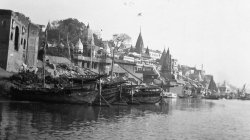
- Boats Bait Beer (Colorized): 1910
- Goose Creek, houses on the water, Jamaica, N.Y. From this Shorpy photo. View full size.
Great work I grew up not that far from here on Long Island,always loved the water and beaches.
(Colorized Photos) ... Posted by Dennis Klassen - 07/27/2012 - 9:35pm -
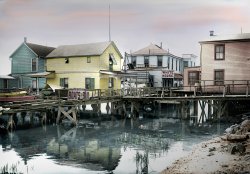
- Chelsea Piers: 1912
- ... all the train/trolley cars are parked?
(The Gallery, Boats & Bridges, DPC, NYC, Streetcars) ... Posted by Dave - 01/15/2024 - 3:02pm -
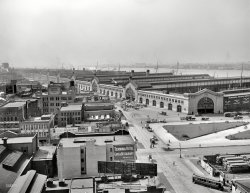
- Dorn Hotel: 1941
- ... a bustling lobster and stone crab trap yard today.
Boats Love these boats, would like to have any one of them. Can some old salt tell us more about ... Posted by Dave - 08/12/2012 - 11:15am -
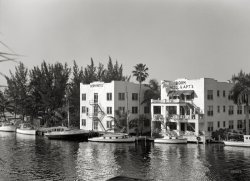
- Queen and Commoner: 1906
- ... "low bridges" across the Ohio. - Dave]
too few life boats! And I thought that the Titanic didn't have enough life boats!
Low clearance There may not have been low bridges, but there were ... Posted by Dave - 07/29/2012 - 2:43pm -
![Queen and Commoner: 1906 The Ohio River circa 1906. "Coney Island Co. sidewheeler Island Queen at Cincinnati." Let her not blind us to the more modest charms of the Guiding Star. 8x10 inch glass negative, Detroit Publishing Company. View full size.
Riggers and allPoor forlorn rowboats! There, I mentioned them so they wouldn't be left out too.
House on the HillAcross the river, on the middle right is a fantastic gothic mansion on top of the hill. Anyone know what that is? I hope it still exists.
The Ohio and the Licking This photo was made near the present day Great American Ballpark from the Ohio side looking south over the river toward Kentucky.
The river in the background going under the bridge is the Licking, which runs between Covington and Newport.
Women and Children FirstEven if we assume there are two more lifeboats on the starboard side, they're gonna fill up fast.
"Guiding Star""Come over and visit us anytime in our humble boat. Please be careful when walking the plank."
Folding StacksI wonder how long and how many crew it took to lower/raise those stacks to get under a low bridge.
[I doubt if there were any "low bridges" across the Ohio. - Dave]
too few life boats!And I thought that the Titanic didn't have enough life boats!
Low clearanceThere may not have been low bridges, but there were low hanging wires. The Island Queen hit one that knocked down her stacks in 1914.
The Guiding Star is most likely a wharf boat for a steamer of the same name. Guiding Star was another excursion boat making trips to Coney Island amusement park.
Re: Folding StacksPerhaps there were no "low bridges" across the Ohio River but there were certainly times of high water. A prior Shorpy post: Steam Under the Bridge: 1906, shows the sidewheeler City of Cincinnati having to fold its stacks in order to pass under a Cincinnati bridge during a period of high water. The Island Queen appears to have similar hinges and rigging to enable lowering its stacks.
Church SteepleThe church to the left of the bridge is the Salem Methodist Church. It had the highest steeple in Newport, KY.
The Church is still standing and is known as The Stained Glass Theater and is used for community theater productions.
However, the steeple was demolished by a tornado in 1986.
View Larger Map
Gaurd dog!Watch out for the little doggy when approaching the Guiding Star.
House on the HillThe "House on the Hill" is actually two houses.
The front one is the Graziani House.
http://www.nkyviews.com/kenton/kenton1941.htm
Its still there but with the fourth/fifth story tower visible in the photo has been removed.
View Larger Map
The one in the back is the Shinkle Mansion, on the other side of Second St. from the Graziani.
http://www.nkyviews.com/kenton/kenton666.htm
It was later donated to the Salvation Army for use as a hospital, and was demolished in 1920; replaced by a newer hospital building.
http://www.nkyviews.com/kenton/pdf/bricking_shinkle.pdf
A regal beauty indeedWow! What a mighty Queen! And moving at a fair clip, judging by the wake, and the spray at the bow.
I always find it disturbing, though, when a ship's flags, and smoke, are blowing in the direction of travel, as they are here.
More on stack heightsAlthough clearance under the later Cincinnati bridges at normal Ohio River water levels may not have been a problem, quite a brouhaha developed further upstream over clearance issues in 1847. The town of Wheeling Virginia (it didn't end up being in West Virginia until the 1863 split) built a suspension bridge to carry the National/Cumberland Road across the Ohio that impeded the passage of taller boats to further upstream ports like Pittsburgh under some river conditions. Hinged stacks could address the issue, but the steamboat operators (who favored high stacks for their boiler draft efficiency and ash/cinder/smoke dispersion benefits) didn't think they should have to bear extra equipment/crew/maintenance costs so bridge developers could save money by skimping on clearance height. Add in the desire of the community to avoid the negative infrastructure/condemnation process impact of higher and necessarily longer approach ramps through already developed areas and you had the makings of a lawsuit.
The steamboat operators were apparently able to convince the state of Pennsylvania that their having to fold their stacks would somehow limit the growth and economic viability of Pittsburgh, so the state championed the case against the bridge that was 50 miles downriver in another state. None other than E. M. Stanton (namesake of a certain serial Shorpy poster) represented the state of Pennsylvania in a landmark lawsuit against the Wheeling and Belmont Bridge Company, but even in losing produced a still important interpretation of the Commerce Clause of the U.S Constitution and clearly demonstrated the need for something like the Interstate Commerce Act, which Congress got around to enacting a quarter of a century later. Someone even wrote a book on the case. At one point, even Mother Nature appeared to weigh into the battle, and on the side of Pittsburgh by taking out the six year old bridge with a storm in 1854. It was rebuilt and survives to this day through laudable preservation efforts.
Dave's crafted photo of the Island Queen is one of the clearest I've see in terms of stack hinge and folding mechanism detail.
Bridges and MansionsRiverboat interests were so strong in Cincinnati that all the bridges were built high enough so the smokestacks wouldn't need to be lowered, at least until certain high water or flood stages anyway.
The Island Queen was used to take patrons between the Cincinnati Riverfront and the Coney Island amusement park that remains today upstream on the Ohio River in the city's California neighborhood. In 1905 the 12 year old steamboat "Saint Joseph" from Mississippi was refitted and renamed the "Island Queen" that we see here. It was destroyed by fire in 1922. There's dozens of great photos of the old gal and her successors at: http://wiki.cincinnatilibrary.org/index.php/Island_Queen
It didn't end wellMy boyfriend's great grandfather, Fred Dickow, was the chief engineer on the Island Queen when it blew up while in port in Pittsburgh, PA. It's said that he lit a welding torch to repair a loose stanchion near some oil tanks causing a spark to ignite an explosion. He was a veteran engineer who had worked for the company for 30 years.
http://news.google.com/newspapers?nid=1144&dat=19470911&id=sFsbAAAAIBAJ&...
MemoriesGrowing up in the Cincinnati area in the late 30s and 40s, I rode the Island Queen to Coney Island Park many times. I had no idea that there was more than one Island Queen, but it appears that they all seem to have been side wheelers, not the more common stern wheelers. In my case, I was much more excited about riding the "Queen" than attending Coney Island. I remember watching the Island Queen approaching the Cincinnati public landing, coming downstream from Coney. I think the steam calliope could be heard all over town! The side wheels would slowly stop, then reverse until she had stopped some what below the landing, then one side wheel would slowly reverse direction and she would slowly turn in place 180 degrees. Then she would move ahead and slowly maneuver to the landing. Beautiful! Once on board I would go to the lower deck to watch the fascinating machinery. There was a huge (at least it seemed huge to me) wood walking beam on each side that connected the engines to the paddle wheels, and they were painted white, trimmed in red, polished, adorned with several large red stars. If I remember correctly, there was an annual race against the Delta Queen. It was very sad to hear of her demise in Pittsburgh.
(The Gallery, Boats & Bridges, Cincinnati Photos, DPC)](https://www.shorpy.com/files/images/SHORPY_4a13298a.thumbnail.jpg)
- Planter: 1865
- ... the rowboats come out to push/pull.
Civil War Era Boats This is the best photo I've seen here in weeks. There's nothing better ... but the "dock" seems to be composed entirely of moored boats, suggesting its temporary nature. Alongside look like canal barges due to ... Posted by Dave - 05/27/2009 - 2:14pm -
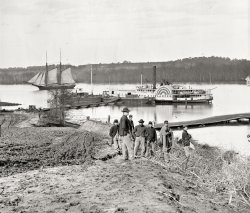
- Sausalito: 1958
- ... Grandmother in Russian...
DaveB
Many, many more boats A contemporary view of the same parking lot (courtesy of Google Earth) ... Posted by Rute Boye - 07/25/2012 - 8:30pm -
![Sausalito: 1958 The yacht harbor in Sausalito, California, shot on Anscochrome circa 1958. I believe this is on Richardson Bay, with Belvedere Point in the background. There are some pretty interesting cars in in this shot, including the mysterious little European-looking thing on the far right. View full size.
SausalitoI believe the "European-looking thing" is an American-made Crosley van. The near ridge is indeed Belvedere Island; beyond that, Tiburon Peninsula. I looked for our 1956 Rambler wagon, but no such luck. [Edited to reflect correction of reversed image.]
Re: BabushkaSo did my Mom's side, all first or second generation California-Italian, despite "Babushka" being Grandmother in Russian...
DaveB
Many, many more boatsA contemporary view of the same parking lot (courtesy of Google Earth) reveals the 1958 photo was taken at approximately 517 Bridgeway in Sausalito.
Landscaping has softened the edges of the dirt parking lot (originally a train yard for Northwestern Pacific Railroad) and the number of pleasure craft has exploded, but the small sheds lining the pier have remained pretty much unchanged.
Impala, SchmimpalaDustyrider said: "Super Sport Chevrolets until 1961."
Ummm, no. The Impala was introduced, as the top of the line Chevrolet, in 1958.
[Confusion arises because he split his sentence between the title and the body of the comment. He was attempting to say "There were no Impala Super Sport Chevrolets until 1961." - tterrace]
Bob Bourke MasterpieceAlthough the pictured Studebaker design came out of the Raymond Loewy studio, it was created by Bob Bourke, with help from several other guys. Loewy normally gets the credit for this landmark Studie, but the design was not his.
Regarding Babushka Lady, does anyone else see a hint of 58 Mercury in the image? Notice that the wing configuration fits a full panoramic windshield, something none of the Chrysler products ever had.
The bodywork on the humble 51 Nash is definitely not the work of George Barris.
First girlfriend's carThat Chevrolet in the third row on the right side looks like the 53 model that my older woman (17) girlfriend picked me up in.
English FordI recognized the green import center front as an English Ford. I remember seeing them back when my mother drove me around in our black 1959 Chevy Impala Super Sport.
Sausalito TodayI decided to take a quick ride down to Sausalito and see if I could replicate the image from 1958. I think I got pretty close, and the changes can be seen.
Another European beautyI'm pretty sure the rightmost car on the third row is a Citroen DS.
Not an Anglia?Not sure if its an Anglia looks more like this a 1952 Consul
love the cars!I see a Willys-Overland Jeep Station Sedan!
Changing face of the US auto marketIn addition to that green Ford Consul and yellow Crosley, I see a blue-green Renault Dauphine next to a Cadillac in the second row, and a VW Beetle and Karmann Ghia in the back row, facing away from the viewer. Still a number of US independents to be seen, in the form of Nash/Ramblers and that lovely black '55 Studebaker hardtop in front of the Consul.
Negative flippedNo one has mentioned that the negative has been flipped here. Notice all the steering wheels are on the wrong side. I want that black Studebaker!
[Wow, extreme blushes from a Marin County native here! It's been fixed, thanks! - tterrace]
Hey! Look for me in the Bay area, 1958I'll be in the VW Bus, California tag #PVD 799.
Summer nights?Hot summer night in Sausalito
Can't stand the heat another mile
Let's drop a quarter in the meter
And hit the sidewalk for a while
--"Sausalito Summer Night"
Diesel, c. 1981
It's a CrosleyA Crosley Panel Truck
1959 or 1960 perhapsI believe I see a 1959 Chevy in the last row, facing the gent walking on the dock.
Little European thingsQuite a few of 'em, actually. Above the Crosley is a Citroen; right in the middle (above the1955 Studebaker Commander Coupe with its, ahem,"European Styling") is a Renault Dauphine; to the left is a black VW Beetle, and above it a black-over-red VW Karmann Ghia. There's also some convertible in the middle of the far row that look vaguely English next to another Bug and to its left, something I'd almost swear was a Volvo PV544. Yep, there's also a '59 Chevy, but it's no Impala.
P.S. I'm told the translation for Reanault Dauphine is, "I rust."
Bound for TahitiAll this talk of cars overlooks a much more significant element to this photo. The large, two-masted schooner at the outermost dock is Sterling Hayden's Wanderer.
Hayden was a major Hollywood heartthrob at the time, but in 1958 he got fed up with the system and walked out on it all. In violation of studio contracts and a court-ordered divorce decree, he sailed off to Tahiti with his four kids on Wanderer. The voyage formed the central thread of the autobiography he published five years later, titled "Wanderer." This photo must have been taken very shortly before he left.
He was not some impulsive pleasure boater though. Hayden had been a sea captain for a long time before falling into Hollywood in the first place. He was frequently canonized as an independent man who didn't care what anybody else thought of him and did not get along with the Hollywood system. But his autobiography paints a much deeper, somewhat sadder picture of a man who never seemed to quite find what he was looking for.
He continued to live in Sausalito for a long time later in life. It's quite likely one of the cars in the foreground of the photo was his, but I don't know what he drove.
Re Hayden, Studebakers, and Precious Bodily FluidsSterling Hayden had an exceedingly interesting life (actor, author, sailor, model, Marine, OSS agent) and I urge everyone to read the Wiki on him. As General Jack Ripper in "Dr. Strangelove", his character's concern for precious bodily fluids helped set the tone for that film's zany atmosphere.
Regarding Studebakers, I sure can relate to the one in this photo because half a century ago the one below (a '54 Starliner) was mine, properly dechromed, lowered and with the anemic stock engine replaced with a Chevy V-8. I was only two years old, of course, so reaching the pedals was a chore.
More carsA red '53(?) Ford F100 in the row nearest the camera, behind it a '58 or '59 Lincoln, to the left is a '58 Chrysler Imperial. In the row near the water, on the right, a '53 Buick Roadmaster parked at an angle. One row closer and a bit left, a '56 Plymouth. Now my eyes are tired.
So many cars!Thanks to Shorpy viewers, the only three vehicles I couldn't make out were identified (the Crosley Van, English Ford, and the Volvo convertible). I was proud to be able to name all of the rest of them, but I won't bore everyone with a recitation of their makes here, unless someone wants to twist my arm!
The English Ford was truly a California carMy Dad was a Ford employee for years, so when I began to drive in the early 1960's he bought me a used Ford Anglia for a few hundred dollars. When I started college in 1965, I purchased a used Anglia station wagon with real wood trim. They were great little cars as long as the temperature was above 28 degrees. Unfortunately Michigan gets much colder in the winter. The starting system didn't have the snap at lower temperatures to start the engine. AAA finally cut me off from road service on the car because of too many push starts. Push it up to 10 mph and pop the clutch and it would start no matter what the temperature. Both had manifold vacuum operated windshield wipers which slowed down when you went up a hill or did a hard acceleration. Both also had the old vacuum tube radios which used a vibrator power supply to boost the 12 volts to the necessary higher voltages. The radio took about 25 seconds to warm up. I still can remember the buzz the vibrator made. I still wonder today what possessed me to buy the second Anglia.
Hayden the WandererCarl H's identification of Sterling Hayden's yacht has to earn the noticing prize for July, even among the Shorpy eagle eyes.
Hayden's unhappiness circa 1958 had another source: in 1951 he "named names" before the House Un-American Activities Committee. Ever after he expressed "contempt for myself since the day I did that." Tahiti turned out not to be far enough away.
Happily, over the last quarter century of his life, he regularly allowed himself to be lured out of "retirement" to make movies. This gave us General Jack Ripper in "Dr. Strangelove" and the crooked Captain McCluskey in "The Godfather."
Miles and Miles of Memories HereThere are lots of childhood memories amid that parking lot. When my dad tired of waiting six weeks for penny ante parts from Coventry, England for our Jaguar Mark VII, he bought a '55 Studebaker coupe in two-tone blue. He loved it. I preferred the Jaguar and called our new main driver the "Stupidbaker". But looking at the one here, I can see why my father remained forever fond of it. And why he was annoyed when at age four, I let the air out of all the tires.
We also had a '57 Chevy coupe and a '59 Impala station wagon that was our favorite family vacation car for many years, so much so that we bought another, identical in every detail and had two for many years.
Our neighbor on one side had a Rambler like the one in the front row, but in metallic kelly green, and another neighbor had a Citreon, in white. Rode in them often enough.
Interesting story about Hayden. I'd like to read that book. Thank you for mentioning it.
There were no ImpalaSuper Sport Chevrolets until 1961.
BabushkaAll the females in my household called the scarf the lady is wearing as she is getting in/out of the Dodge Wagon a babushka.
Volvo ConvertibleAs a long time Volvo owner, not sure if Volvo ever sold a convertible in the US back then; the P1900 was built during this time period [67 built], but it was more of an experiment to test market reaction, it led to the P1800 of 1962. And a Volvo dealer, Volvoville on Long Island, NY, later converted a few P1800 coupes into convertibles, but without Factory blessing. That PV-544 might be a PV-444; if it's the car I think it is, you can't tell if the windshield is two piece [444] or one piece [544]. Great picture and interesting info about Hayden.
The UK Ford......is in fact a 'Zephyr', the 6 cylinder big brother to the Consul. The Zephyr has a different front grill and hood and, unlike the Consul, has the chrome hood ornament that can just be seen in the photo. Also evident is the small chrome trim on the side fender just above the front wheel that was also not fitted to the Consul. I spent many an hour back in the day under the various products from Mr Ford, including these models. Thanks again Shorpy for my daily 'fix'!
Punch Bug, Light BluePunch Bug, Light Blue!
or is that Slug Bug? I never remember.
LuxuryI love seeing the front of the Lincoln Continental and the rear of the Imperial. Both cars are showing off their most distinctive features.
Sterling Hayden's addressSome are saying that Hayden lived in Sausalito. He had a magnificent old house on the very top of Belvedere Island south, a block away from my parents' after 1958. I remember our dogs didn't get along with his, not that he noticed.
(ShorpyBlog, Member Gallery)](https://www.shorpy.com/files/images/SausalitoCars.thumbnail.jpg)
- Lady in the Water: 1947
- ... springs as a kid.......and riding the glass bottomed boats ....... and seeing the beautiful silvered caves ........ the light ... Posted by Ken - 08/19/2018 - 12:31pm -
![Lady in the Water: 1947 A model floating in the water at Weeki Wachee Spring, Florida. This image, by fashion photographer Toni Frissell, was published in Harper's Bazaar in December 1947. Mug | Weeki Wachee Mermaids | View full size.
Very intresting picture, itVery intresting picture, it trigures a lot of questions!
[I can think of two. - Dave]
StunningSo ethereal and mystical. Breathtaking. http://flamingcurmudgeon.wordpress.com/
That is among the mostThat is among the most beautiful photos I've ever seen.
Also a Blue Note album coverThis was used as the cover for the amazing collaboration between Bill Evans and Jim Hall, Undercurrent, on Blue Note Records, in 1962:
http://www.bluenote.com/detail.asp?SelectionID=10162
Evan
http://www.pheezy.com
Floating Lady PrintPrint now available at in both square and horizontal formats.
What a fantastic photo.What a fantastic photo.
It's perfect for framing!
[Yes. Sofa size! - Dave]
Great picHow did they do this one Dave?
It is a beautiful shot
[My first thought was underwater camera, then I remembered visiting Weeki Wachee as a kid. They had an underground theater with a glass wall looking into the springs. The main attraction was the Mermaid Show. This picture was taken at Weeki Wachee Springs the year it opened, 1947. See the comment above for some more photos, from old postcards. - Dave]
Weeki Wachee mermaidsSome vintage postcard views of the mermaid show through the windows in the underground theater. Weeki Wachee Springs is a tourist attraction in Florida.
Weeki Wachee still existsWeeki Wachee still exists and is a very surreal experience in Americana. I suggest a visit if you ever have the time to head a couple hours north of Tampa, FL.
Great pic, and albumBeautiful -- I can't believe I didn't recognize it though, and I've owned the album for years.
David
http://neversealand.downtothesea.org
floating ladya friend just sent this link to me ....... odd as we were just discussing how we would like to be buried ( a fellow blogger passed away this week - so i apologize in advance for the morbidity)....... i said that i wanted to be sunk in one of those caves underwater in the springs down in florida ....... my friend thought this was quite odd.......but i remember visiting silver springs as a kid.......and riding the glass bottomed boats ....... and seeing the beautiful silvered caves ........ the light slicing through the water....... splinters of fish darting ........ i found it to be a soothing image - eternally floating...... i truly love this shot - beyond breathtaking. the image penetrates the soul. evocative.
Like that broad in Titanic, only face-upEerie and beautiful. Being fully clothed, and black and white, makes it fascinating
Amazing PhotoReally hypnotic!
how was it done?if this was done thru a glass wall looking into the springs, how did they get to be so sharp, with no refractions, etc?
please please tell me, i have to know. (!!!)
:D
Another album cover...In addition to serving as the cover of the Blue Note Bill Evans/Jim Hall Undercurrent album, this photo now appears on the CD cover of Osvaldo Golijov's Oceana recording on the Deutsche Grammophon label...
FloatingHaunting. I'll probably by the print.
There is a photo of actress Kate Winslet that was also taken underwater that might have been inspired by this. She's wearing a similar dress, but is completely submerged.
Proper terminologyGiven that they're in the water, I believe the correct word is "bosuns."
Trying to be true to the mores of the times, here.It is interesting how pert she appears, if you know what I mean. In a standard gravity when lying on the back, her bosums would sink into her chest, yet here they appear to float upwards and not in an unappealing manner.
["Bosums," eh? - Dave]
Trying to be true to the moron of the times, hereThanks for the anatomy lesson, though I think you actually "bosom," if you know what I mean. (I think she only had one chest, unless there's something under her garment that you could see but I couldn't.) Besides your x-ray vision, what really intrigues me is how you managed to reduce the whole person into just her breasts - "she" is "pert?" Hey, no arguing she's a beautiful woman, but she is a woman and not a pair of gravity-defying tits.
Trying to be true to the mores of the times, here.Water = buoyancy i.e. lack of gravity. So, as a woman I can say with all assurance… yes they float.
Weeki Wachee MermaidsNice profile of present-day Weeki Wachee Mermaids in Sunday's (1/6/08) New York Times. Some of today's mermaids look like they would float nicely, too.
Goober Pea
Blue Note LinkThe other link for the album cover wasn't working for me. Try this one:
http://www.bluenote.com/ArtistMain.aspx?ArtistId=907925
HairVery interesting to see how the hair holds up very well in the water. They did a good job with the hair. It is so beautiful.
FloatingThis is by far one of my fave photos on the site. Just a perfect shot thru and thru.
TetheredI thought the image in this book cover looked familiar! I wonder if the cover designer is a Shorpy reader?
Bruce MozertThis picture reminded me of the underwater photography of Bruce Mozert.
TetheredRe the "Tethered" book cover, I e-mailed the author, Amy MacKinnon. Her reply:
Toni Frissell was a consummate artist. I chose that photo because it captures perfectly the spirit of my book. The brilliant art director at Random House infused it with color and the blending of two forms was the result. I believe I was gifted with the most gorgeous cover ever.
Best,
Amy
I've been trying to find this for years!I saw this photo maybe 10 or 15 years ago in a Smithsonian magazine, and cut it out and put it on my wall. It got crinkled over the years through the move to college and various apartments, and though I tried a few times to find the issue it came from or the photographer's name, or really anything else about it, I never could. Thank you so much for posting it!
Lady in the water !A great picture !
King Neptune’s Court I am working at Weeki Wachee restoring some of the props.
I would like to restore King Neptune’s court to the original colors, and looking for a color photo. The photo would probable be from the 50s and 60s. If anyone have a photo of the King, can you please email a copy to me?
Thank you,
Evie
[We'd need your e-mail address. Have you looked on eBay for Weeki Wachee postcards? - Dave]
Mermaids of the Springs these daze.Hi my name is Mermaid Karri. And I've been swimming at Weeki for a little more than 4½ years. The best job I'll ever have. I love the history and the people how are so amazed by what us girls do seven days a week. For me its a passion that I'll never forget. And hope to swim in that spring forever. I will like to share so of my photos with you and hope you can enjoy them as much as I do. So enjoy and leave a comment if you like.
Siren of the Springs,
Mermaid Karri
Another album cover!http://projekt.com/projekt/product.asp?dept_id=10&sku=PRO00115
You never know...
Band posterThe Dead Weather has a new set of concert posters out, one of which incorporates this photo.
BreathlessLove love love the mermaids! I remember watching them on the Walt Disney tv show on Sunday nights. I was always so intrigued by how long they could swim without taking a hit of air from the strategically placed underwater breathing tubes.
Happy to see that they still swim on! Will have to go see them next time we're in Florida.
Robert MontgomeryWould have gotten a real kick out of this photo! I was immediately reminded of the noir movie "The Lady In The Lake' that he did where the camera was used as his vision of the surroundings. You only actually saw him if he went to a mirror and looked at his reflection. Neatly done. I know this is way past the point of inclusion, but thought I'd share my thoughts anyway.
(The Gallery, Bizarre, Portraits, Pretty Girls, Toni Frissell)](https://www.shorpy.com/files/images/weeki_wachee.thumbnail.jpg)
- Duluth: 1905
- ... all the way to the top of the bluff today.
Note the boats Not only trains but boats here. A lot to see.
American Plan! It's so cool to see this ... Posted by Dave - 08/13/2012 - 7:04pm -
![Duluth: 1905 Duluth, Minnesota, circa 1905. Detroit Publishing glass negative. View full size.
Familiar facadesMany of the buildings in this photo still exist. The large stone building in the upper left is the old Central High School, now the Central Administration Building for the ISD. It was built in the 1890s.
I wonder if the Pickwick sign is a company associated with the operators of the Old Saloon at the original Fitgers Brewery. This turned into the Pickwick restaurant, which is still in operation. One of the train cars is a Fitgers Beer reefer.
Railyard playgroundI find the variety of people and animals hanging around the railyard in almost every photo on here interesting. Here we see a bunch of kids playing around the freight cars. The days before Thomas the Tank Engine! The other day it was free range chickens! Just interesting is all, how different we are today.
Hey you kids!Look at all the little boys running around! Plus the barefoot kid on top of the boxcar and his friend down below. Doesn't seem prudent but I bet it was fun.
Ol' swaybackSeriously overload gondola car, on our far left.
So many still aroundMany of the companies and products seen on signs in this picture are still around after more than 100 years. Armour Foods, Quaker Oats, Coca-Cola, Duluth Paper, both Pabst and Hamm's beer, National Biscuit (Nabisco), probably others.
Must be JulyNo snow and the water isn't ice.
School TimeThe Old Central High School with its two wings and clock tower was, and remains, a very imposing building.
Duluth TodayAs a Duluth resident,I greatly enjoyed this photo! Many of the buildings in the photo are still around - notably the tall-spired one in the left-center. That's the former Central High School.
Duluth is undergoing a renaissance today and appreciation of the old buildings, the spectacular setting on Lake Superior and the rugged hills has never been greater! I love living there!
Old downtownLooks to be a shot across Main Street in what is today's old downtown section. Houses are built all the way to the top of the bluff today.
Note the boatsNot only trains but boats here. A lot to see.
American Plan! It's so cool to see this outdated term on a hotel sign.
FloatingSeems like the photographer must be situated somewhere on the waterfront. Any ideas on his vantage point?
[Many of the Detroit Publishing city views were taken from water towers. - Dave]
Duluth & Iron Range R.R.The reporting marks on what appear to be early hopper cars and the much abused gondola are for the Duluth & Iron Range Railroad (predecessor of the current Duluth Missabe & Iron Range). Presumably the ore cars are hauling ore from the Soudan Mine, which makes me wonder if some idiot filled a gondola with iron ore. Probably not though. My guess is that it's an old car filled with stone, coal or clinker.
Lake AvenueThe bridge crossing the tracks appears to be South Lake Avenue. The tracks have since been replaced by I-35. The stone building to the left with the clock tower is the (still standing) historic Central High School.
Can you spot the cannon?What a great photo, so much going on. I'll keep coming back to this one. Thanks to all who provided the local updates and building identification. Is the cannon still there?
AwesomeThanks once again for a picture of my local area. Like others said some of these buildings are still around. Amazing to see this area when it was a real working class place rather than the tourist area it has become. Thanks again Shorpy
About face, perhaps?It would be wonderful if, before climbing down, the 1905 photographer had also turned his camera in the opposite direction (east), to capture the sparkling new Aerial Lift Bridge over the just-renovated Duluth Ship Canal.
[This photo is part of a six-frame panoramic view. There's a photo of the bridge here. - Dave]
FunnyI'm hoping the lumber sash and door place sold better stuff than what was on the building.
RecyclingThe cannon was sold as scrap iron in 1942 and was melted down and used during World War II. Because there was so much protest over the sale of the cannon, a flag pole was erected in 1949 on the spot where the cannon stood.
Details here.
Boy of the North CountryWhere was Bob Dylan born 36 years later?
Saved the BestCentral High School Building is fantastic. You could get lost in the details and beauty of this Architecture. Sorry about the cannon, but the Building survives!
Railroad NutBecause I am a nut about railroad history, I just love those old railroad cars.
Love these Duluth photos!Its hard to believe my grandpa was 16 years old and living in Duluth when these photos were taken. Maybe he's one of those kids playing by the tracks
A lonely survivorWho would have guessed that the Tremont, along with its ghost sign, was a survivor?
We can fix ol' swaybackThat old gon could be straightened out by adjusting the turnbuckles under the car. Those cars had truss rods supporting them. If it's not too far gone a big wrench and a level will fix it.
So Much to See I have one of these panoramas framed in my home. Everytime I look at it I see something new. The tram, the Central Tower, and down by the Steam Plant, which used to be the place to stay away from (bowery area). Wouldn't the photographer be shocked to see Canal Park today!
(The Gallery, Boats & Bridges, DPC, Duluth, Railroads)](https://www.shorpy.com/files/images/4a06770a.thumbnail.jpg)
- White House Landing: 1862
- ... May-August 1862. View full size.
Schuykill canal boats' second career The Philadelphia & Reading Railway took a big ...
Boogle Thanks Beeguy. I was curious about those odd boats and your concise, informative comment hit the spot. You're better than ... Posted by Dave - 01/31/2019 - 8:53pm -
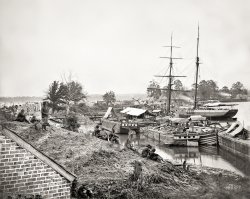
- Jackknife Bridge: 1907
- ... on the top. Maybe someone's homemade houseboat?
Odd boats! The boat on the left reminds me of The African Queen, and the one on ... to the US a mere 16 years ago.
(The Gallery, Boats & Bridges, Chicago, DPC, Railroads) ... Posted by Dave - 08/21/2012 - 11:20am -
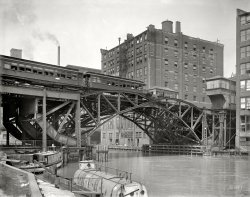
- The Yacht Club: 1906
- ... done with the old place!
Gaff rigged boats Much prettier than the more modern Bermuda/Marconi rig.
Takes a bit more skill, but rewarding to sail.
(The Gallery, Boats & Bridges, Boston, DPC) ... Posted by Dave - 02/10/2017 - 12:12pm -
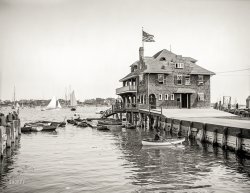
- Beantown Bathers: 1906
- ... was an acceptable level of misery back then.
Bygone boats A great collection of catboats, sloops and schooners, plus a couple of Noman's Land boats and apparently electric launches.
(The Gallery, Boats & Bridges, ... Posted by Dave - 08/03/2012 - 3:06pm -
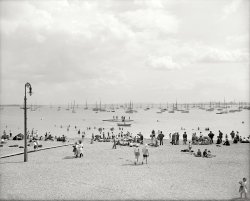
- The Submarine Boat: 1904
- ... the foot of the steps.
The heck with the Submarine Boats Let's go see the Baby Incubators!
Now that's something not even ... Posted by Dave - 08/20/2012 - 1:30pm -
![The Submarine Boat: 1904 New York circa 1904. "The Submarine Boat, Coney Island." 8x10 inch dry plate glass negative, Detroit Publishing Company. View full size.
Get your incubators here!Boy, Coney Island had everything back then! Been needing an incubator for your infant? After you take in the Submarine Boat, step right down and grab one for your ride home.
Ice cream? Yuck.Hundreds of people on the boardwalk, and not one wants any ice cream.
Love the fake guns!Total kitsch! The lifeboats, smokestack, boiler room ventilators, even a pretty good imitation of a torpedo at the foot of the steps.
The heck with the Submarine BoatsLet's go see the Baby Incubators!
Now that's something not even Disney has in its parks.
Stub HubIn any case the price was right, 15¢ for Adults, 10¢ for Children. I guess it was affordable. What does that Capt Nemo Submarine Ride at Disneyland (or is it Disney World) cost?
C'mon MargeWe can get an infant incubator over by the submarine boat.
Prime AttractionAt 15 cents a pop, this was the E-ticket attraction of its day.
Sixty Years Before Disney's Submarine Ride"Under and Over the Sea," the park's showstopper,. was located on the west promenade near Beacon Tower. The building was constructed along the lines of a Man-of-War with turrets, protruding guns, lifeboats and a deck. E.C. Boyce's attraction offered the public a simulated submarine ride under the Atlantic, where viewing the action through portholes, they experienced a confrontation with a giant squid, sharks and other strange inhabitants of the deep. It was reminiscent of the adventure scenes in Jules Verne's exciting novels which boys read enthusiastically at the turn of the century. Those waiting in line for the ride on a miniature island could trace the submarine's path via a little flag remaining above the surface.
["The Submarine Boat" and "Under and Over the Sea" were two different rides. More on the various Dreamland attractions here. - Dave]
Infant Incubators?I'm not sure I really want to know.
[Quite interesting. More here. - Dave]
The Best PartFunny, I think the guy behind the counter of the ice cream stand with the tray on the counter is the best part of the picture. Just a workaday guy getting ready for business. You don't usually see something like that in old pictures.
Only "quite interesting"?I did some following up and found the whole story of Coney Island infant incubators to be absolutely fascinating. It's a tremendous story -- and was rather a shock to realise, that for so many years, hospitals didn't think premature infants were worth saving.
My father was born very prematurely in 1929 - and ended up in the warming tray of the oven to keep him alive because no facilities existed in the local hospitals - I suppose I rather think he was worth saving!
I'd assumed incubators hadn't been invented... but they'd actually been available for years.
There is a little more (actually a lot more) information here if anyone is interested.
http://www.neonatology.org/pinups/coneyislandnurses.html
(The Gallery, Coney Island, DPC)](https://www.shorpy.com/files/images/4a17577a.thumbnail.jpg)























